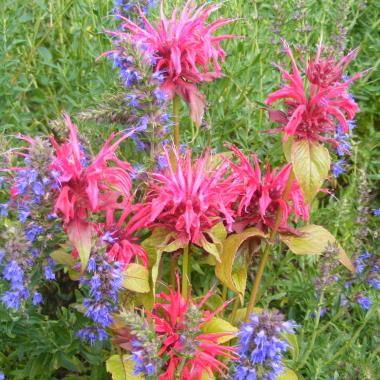


Bergamot Red (Oswego tea or Bee balm)
Monarda didyma

Monarda plants thrive in a sunny position in moist rich soil.
They spread by running stems on, or just below, the soil surface to give a clump of up to 90 cm wide after 2 or 3 years
under ideal conditions.
The crushed leaves have a spicy scent from their essential oils.
The bright red flowers are arranged in whorls towards the top of the flowering stems.
These are rich in nectar, attracting bees, hoverflies and other pollinating insects — hence its common name of bee balm.
The Monarda or bergamot plants have a long history of use as a medicinal plant by the Native American people.
The plants are found in the wild across N. America in moist meadows and forest glades.
The plants are a natural source of thymol, which is an antiseptic compound which is used nowadays
in some modern mouthwash formulations.
Infusions of the leaves were used by the Native Americans for a variety of ailments from mouth and throat infections to flatulence.
To make bergamot tea at home you need about a ¼ of a cup of crushed fresh leaves in a jug.
Pour over a cup of boiling water and leave to infuse for up to 5 minutes before straining into your cup.
The leaves can be dried for winter use and stored in the dark in small jars, less of the dried herb is needed for infusions,
usually 2 tsp will be sufficient.
Fresh honey or lemon juice can be added to taste.
The tea has a relaxing effect and can also be drunk to combat digestive disorders and nausea.
Bergamot tea should be avoided during pregnancy and if you have menstrual problems, if in any doubt consult your doctor.
The presence of thymol in the foliage gives it a rather bitter taste, rather like a mix of mint with oregano.
The Native Americans used it as a seasoning for wild game, its minty spicy flavour makes it ideal to experiment
with the shredded young leaves and the flower petals as an addition to pizza, salads and breads.
Try it sparingly to begin with until you are happy with the flavour.
The dried leaves have a much stronger flavour and can be used as an addition to chilli, salsa and other spicy dishes.
The foliage and flowers also make a fine addition to sweet dishes like fruit salads.
Bergamot Fruit Salad
This is a great summer fruit salad to make when there is loads of soft fruit available, the bergamot syrup really enhances the flavours of the fruits.
- 5 or 6 large bergamot leaves
- 100 g caster sugar
- 180 ml water
- 150 ml orange juice
- 100 g redcurrants or blackcurrants if these are not available
- 300 g strawberries
- 200 g raspberries
- Bergamot petals to decorate
Warm together the juice, water, sugar and bergamot leaves over a low heat.
Once the sugar is dissolved increase the heat to a boil for 5 minutes until the syrup has reduced.
Remove the bergamot and add the redcurrants.
Simmer gently for a further 5 minutes then leave to cool.
Remove the green tops from the strawberries and halve them.
Put into your serving dish with the raspberries and pour over the cooled redcurrant syrup.
Decorate with the bergamot petals as an edible garnish.